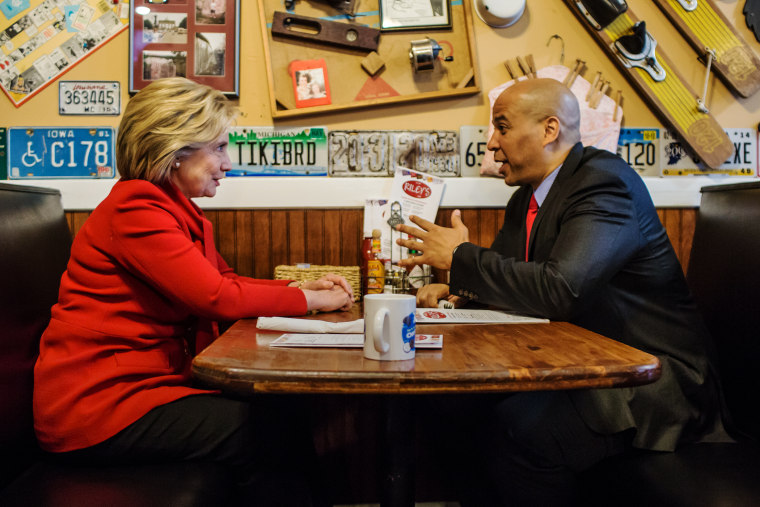Presidential nominees have many competing considerations to weigh when choosing a vice presidential nominee, but one of the biggest for Hillary Clinton will be the makeup of the Senate.
Most of Clinton’s best VP prospects are found in the upper chamber, since Democratic governors have been decimated in recent years and few House members have the proper profile.
But at least three of the likely Democratic nominee’s top potential choices -- Elizabeth Warren, Sherrod Brown and Cory Booker -- are senators from states with Republican governors, meaning they would almost certainly be replaced in Congress by a Republican, which could alter the balance of power in the Senate.
That may be enough to keep Clinton and her team focused on senators from states with Democratic governors, such as Virginia’s Tim Kaine or Minnesota’s Al Franken and Amy Klobuchar, or non-senators, like Labor Secretary Tom Perez or HUD Secretary Julian Castro.
Democrats have a good chance to recapture the Senate in November, but selecting one of these candidates would mean one fewer Democratic vote for a hypothetical Clinton administration next year.
In the worst case, the extra Republican could cost Democrats control of the upper chamber. In the best case, it would mean a narrower margin of error on tough legislative and confirmation votes, including to the Supreme Court.
RELATED: Did Ben Carson reveal Trump's vice president shortlist?
Ironically, Warren’s ascension to the vice presidency could even empower conservative Democrats like West Virginia’s Joe Manchin, whose vote might suddenly become decisive for a narrow Democratic majority.
All this would happen during the critical early months of Clinton’s presidency, which is historically the most legislatively fruitful portion of any administration.
In President Barack Obama's first 100 days, for instance, he passed the stimulus package, expanded a children’s health insurance law, signed the Lilly Ledbetter gender equal pay law, got his first budget approved, and made significant progress on what would become Obamacare.
Meanwhile, Democrats are trying to bank as many Senate wins as possible in 2016, when the map tilts in their favor, in order to withstand the 2018 midterm election, in which the map favors Republicans. So even if Warren or Brown’s ascension to the the Naval Observatory didn’t impact the balance of the Senate this year, it could only two years down the road.
Laws vary from state to state, but Clinton would have to contend with an extra Republican in Senate for a minimum of about five months if she picked Warren, or nearly two years if she picked Brown.
RELATED: Reports: Hillary Clinton considering Elizabeth Warren for VP
If Clinton picked Warren, Massachusetts Republican Gov. Charlie Baker would choose a replacement until a special election could be called, which state law requires occur between 145 days and 160 days after the vacancy.
Senators selected to serve in a president’s cabinet typically resign around the president’s inauguration, which starts the clock on filling the vacancy.
Massachusetts is a Democratic state, but Senate races are still expensive and hard-fought, especially in off-years when turnout is low, which hurts Democrats. Republican Scott Brown won thanks to a special election in 2010 to replace the late Sen. Ted Kennedy.
The situation is even worse if Clinton picked Brown. Republican Ohio Gov. John Kasich’s hand-picked senator would get to stay in office for nearly two years, until the midterm in November of 2018, according to the secretary of state’s office.
Brown is up for reelection 2018 and will face a challenging race regardless, but incumbents tend to have a strong advantage in reelection fights. Now it would be Republicans who have the benefit of incumbency. Brown would be a loss for Democrats, too, since has already won twice and is relatively popular in Ohio.
In New Jersey, the situation is a bit more complicated thanks to an apparent drafting error in state law. It gives two conflicting mandates on when appointed senators get replaced by an election. But it would be either November 2017 or November 2018, both of which are a long time.
New Jersey hasn’t elected a Republican to the Senate in nearly 45 years. But at the very least, a Senate election there in 2018 (Booker isn’t up for reelection until 2020) would divert precious resources to an expensive state in a year Democrats are on defense.
Governors rarely appoint a member of the opposite party to fill a Senate seat. There are occasional exceptions -- former New Hampshire GOP Sen. Judd Gregg convinced the state’s Democratic governor to appoint a Republican when he was up for an Obama cabinet position -- but Clinton should expect Warren and the others to be replaced by a Republican.
RELATED: Sherrod Brown rejects interest in vice presidency
When Obama was elected in 2008, Democrats lost some governorships and Senate seats as he filled out his cabinet.
Republican Mark Kirk won the Illinois seat formerly occupied by Obama himself in a special election in 2010, even though it is a staunchly Democratic state. The party lost governorships in Kansas and Arizona after Obama elevated then-Govs. Kathleen Sebelius and Janet Napolitano to his cabinet.
Democrats kept the Colorado Senate seat left behind by Ken Salazar, who become Secretary of the Interior, but only after one of the most expensive Senate races of 2010.
And Republican Gov. Chris Christie has already proven he has no qualms about appointing a Republican to fill a Democratic seat. In 2013, he selected his friend Jeffrey Chiesa to fill the seat created by Democratic Sen. Frank Lautenberg’s death.
